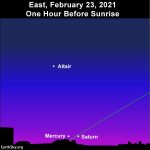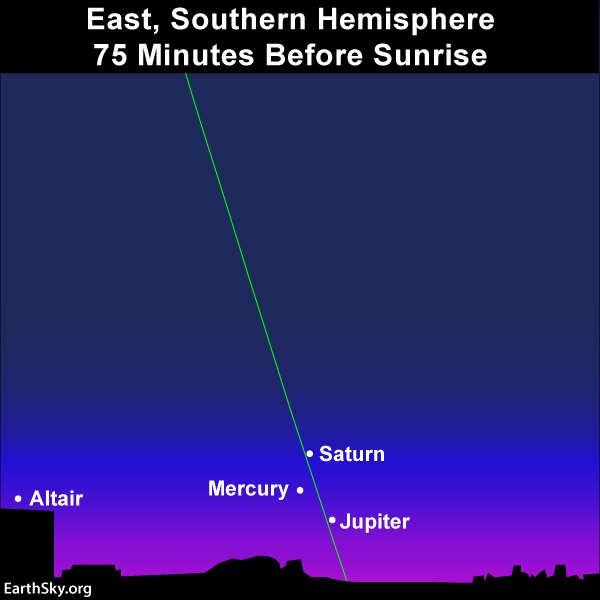
The bright planets Mercury and Saturn will meet for a quasi-conjunction on February 23, 2021. Although both of these worlds shine as brilliantly as the sky’s brightest stars, Mercury and Saturn will be hard to see with the eye alone in the glow of morning dawn. Look eastward as the predawn darkness is giving way to morning twilight. Binoculars will be helpful.
What’s a quasi-conjunction? Two planets are said to be in conjunction if they’re north and south of one another (in right ascension) on the sky’s dome. If two planets come to within 5 degrees or less of one another without being in conjunction, then it’s called a quasi-conjunction. At their closest, these two worlds will be 4 degrees apart on February 23, at about 08:00UTC. For reference, the width of two fingers at arm’s length approximates 4 degrees of sky.
The Southern Hemisphere has the advantage for spotting Mercury and Saturn before sunrise. We give the approximate rising times for Mercury and Saturn at various latitudes (given an absolutely level horizon):
40 degrees north latitude: Mercury/Saturn rise about 1 1/6 hour(70 minutes) before the sun
Equator (0 degrees latitude): Mercury/Saturn rise about 1 1/2 hours (90 minutes) before the sun
35 degrees south latitude: Mercury/Saturn rise about 1 5/6 hours (100 minutes) before the sun
For more specific info, go to Old Farmer’s Almanac (US and Canada) or TimeandDate (worldwide)
From mid-northern latitudes, Mercury and Saturn shine pretty much side by side over the eastern horizon, and rise at roughly the same time. Farther south, Saturn rises before Mercury does, so Saturn is the higher up of these two planets at southerly latitudes. (See sky chart below.) The rising times listed above are for the planetary pair, or when both planets finally climb above the horizon.

This chart is for 35 degrees south latitude, where the steep tilt of the ecliptic brings the morning planets higher in the sky. At this southern latitude, you also have a good chance fof spotting Jupiter, the brightest of these 3 planets. At northerly latitudes, Jupiter may be too close to the sunlit glare to be visible.
If you miss Mercury and Saturn on February 23, don’t give up. Mercury and Saturn will remain fairly close together for the rest of February, and Mercury will meet up with the king planet Jupiter for a conjunction on March 5, 2021.
Bottom line: Will you catch Mercury pairing up with Saturn in the eastern sky before sunrise on February 23, 2021? Southern Hemisphere viewers have the best shot at seeing these planets.
from EarthSky https://ift.tt/3pHaLHr

The bright planets Mercury and Saturn will meet for a quasi-conjunction on February 23, 2021. Although both of these worlds shine as brilliantly as the sky’s brightest stars, Mercury and Saturn will be hard to see with the eye alone in the glow of morning dawn. Look eastward as the predawn darkness is giving way to morning twilight. Binoculars will be helpful.
What’s a quasi-conjunction? Two planets are said to be in conjunction if they’re north and south of one another (in right ascension) on the sky’s dome. If two planets come to within 5 degrees or less of one another without being in conjunction, then it’s called a quasi-conjunction. At their closest, these two worlds will be 4 degrees apart on February 23, at about 08:00UTC. For reference, the width of two fingers at arm’s length approximates 4 degrees of sky.
The Southern Hemisphere has the advantage for spotting Mercury and Saturn before sunrise. We give the approximate rising times for Mercury and Saturn at various latitudes (given an absolutely level horizon):
40 degrees north latitude: Mercury/Saturn rise about 1 1/6 hour(70 minutes) before the sun
Equator (0 degrees latitude): Mercury/Saturn rise about 1 1/2 hours (90 minutes) before the sun
35 degrees south latitude: Mercury/Saturn rise about 1 5/6 hours (100 minutes) before the sun
For more specific info, go to Old Farmer’s Almanac (US and Canada) or TimeandDate (worldwide)
From mid-northern latitudes, Mercury and Saturn shine pretty much side by side over the eastern horizon, and rise at roughly the same time. Farther south, Saturn rises before Mercury does, so Saturn is the higher up of these two planets at southerly latitudes. (See sky chart below.) The rising times listed above are for the planetary pair, or when both planets finally climb above the horizon.

This chart is for 35 degrees south latitude, where the steep tilt of the ecliptic brings the morning planets higher in the sky. At this southern latitude, you also have a good chance fof spotting Jupiter, the brightest of these 3 planets. At northerly latitudes, Jupiter may be too close to the sunlit glare to be visible.
If you miss Mercury and Saturn on February 23, don’t give up. Mercury and Saturn will remain fairly close together for the rest of February, and Mercury will meet up with the king planet Jupiter for a conjunction on March 5, 2021.
Bottom line: Will you catch Mercury pairing up with Saturn in the eastern sky before sunrise on February 23, 2021? Southern Hemisphere viewers have the best shot at seeing these planets.
from EarthSky https://ift.tt/3pHaLHr

Aucun commentaire:
Enregistrer un commentaire